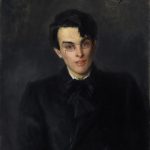
“Autoportrait Avec Récipient Noir” is a captivating artwork by the Austrian painter Egon Schiele, renowned for his distinct style that often pushed the boundaries of traditional portraiture. This particular self-portrait, created in 1911, showcases Schiele’s mastery in capturing the complexity of human emotions and his willingness to experiment with form and content.
At first glance, the viewer is drawn to the enigmatic presence of Schiele himself. The artist boldly positions himself in the foreground, his gaze penetrating directly into the viewer’s soul. Schiele’s self-portraits are known for their intense introspection and raw honesty, and “Autoportrait Avec Récipient Noir” is no exception. The use of dark, earthy tones enhances the emotional depth of the piece, creating an almost intimate connection between the artist and the observer.
The title itself, translating to “Self-portrait with Black Vessel,” adds an intriguing layer to the interpretation of the artwork. The inclusion of the black vessel, a recurring motif in Schiele’s oeuvre, introduces an element of mystery. The vessel, held firmly by Schiele, becomes a symbol open to multiple interpretations. It could represent containment, introspection, or even the complexities of the human psyche. Its dark hue contrasts sharply with the artist’s pale, almost ghostly, complexion, emphasizing the dichotomy between internal and external realms.
One cannot ignore the artist’s distinctive use of line and form in “Autoportrait Avec Récipient Noir.” Schiele, a protégé of Gustav Klimt, absorbed elements of Art Nouveau and symbolism but evolved towards a more expressionistic style. His elongated, sinuous lines create a sense of tension and distortion, adding a psychological depth to the portrait. The contorted posture of Schiele reflects a palpable psychological intensity, hinting at the internal struggles and conflicts within the artist’s mind.
The choice of self-portraiture as a recurring theme in Schiele’s body of work is significant. It suggests not only self-exploration but also a defiance of societal norms. Schiele, often considered controversial in his time, did not shy away from delving into the complexities of the human experience, including themes of sexuality and mortality. In “Autoportrait Avec Récipient Noir,” the artist confronts the viewer with his unapologetic gaze, challenging conventional notions of self-representation.
The background of the painting is as crucial as the foreground. The muted, somber tones create a stark contrast with Schiele’s figure, intensifying the emotional impact. The absence of any discernible setting places the focus squarely on the artist and the black vessel, fostering a sense of isolation. Schiele’s deliberate choice to eliminate contextual elements allows the emotional resonance of the self-portrait to take center stage.
Furthermore, Schiele’s brushwork is both dynamic and deliberate. The visible, textured strokes contribute to the overall emotional charge of the painting. Every stroke seems purposeful, adding layers of complexity to the portrayal of the artist’s psyche. The juxtaposition of smooth and rough textures enhances the visual and tactile experience, inviting the viewer to engage with the painting on a visceral level.
“Autoportrait Avec Récipient Noir” can be seen as a snapshot of Schiele’s internal world, frozen in time. It invites contemplation on the nature of selfhood, the struggles inherent in the human condition, and the role of art as a means of expressing and grappling with the complexities of existence. The dark vessel, a symbol of containment, may also be interpreted as a receptacle for the artist’s thoughts, emotions, and inner turmoil.
In conclusion, Egon Schiele’s “Autoportrait Avec Récipient Noir” stands as a testament to the artist’s uncompromising exploration of self and his ability to convey profound psychological depth through visual expression. The painting’s enigmatic composition, bold use of color and form, and Schiele’s unflinching gaze collectively contribute to a timeless masterpiece that continues to captivate and intrigue art enthusiasts, prompting introspection and contemplation on the intricacies of the human experience.





